A) innovate
B) increase social surplus
C) hire fewer resources in production
D) decrease deadweight loss
Correct Answer

verified
Correct Answer
verified
Multiple Choice
Scenario: Tobac Co. is a monopolist in cigarette market in Nicotiana Republic, where the U.S. dollar is used as the official currency. The firm has a constant marginal cost of $2.00 per pack and the fixed cost is $20 million. Through market research, the firm has found that there are two types of customer, Type 1 and Type 2. The demand curves of the two types of customers, and the total market demand curve, along with respective marginal revenue curves, are shown in the following figure.
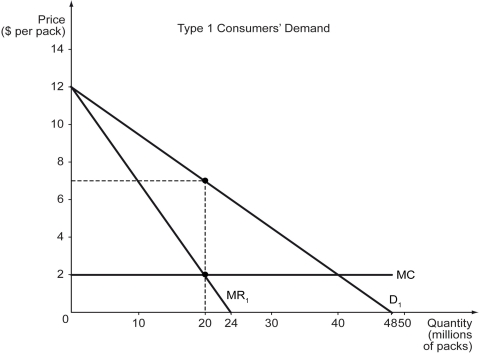
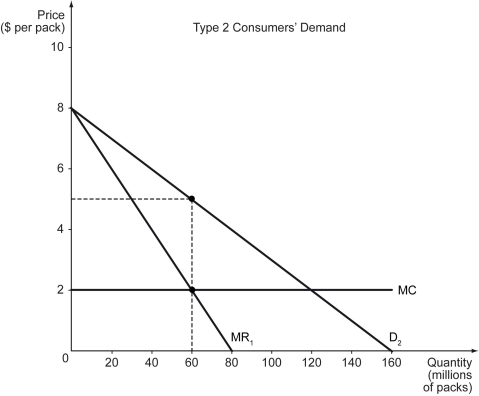
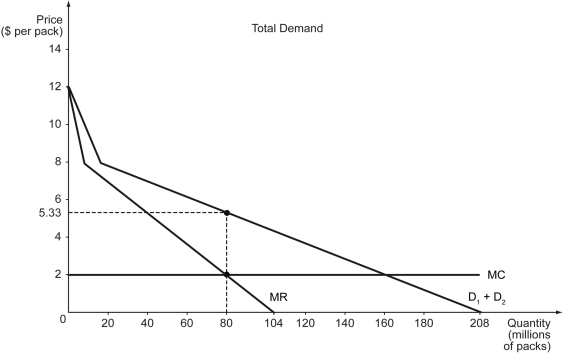 -Refer to the scenario above.If Tobac Co.could not carry out price discrimination,the firm would sell ________ as it would under the third-degree price discrimination.
-Refer to the scenario above.If Tobac Co.could not carry out price discrimination,the firm would sell ________ as it would under the third-degree price discrimination.
A) half as many packs
B) as many packs
C) twice as many packs
D) three times as many packs
Correct Answer

verified
Correct Answer
verified
Multiple Choice
The following figure shows the marginal revenue (MR) and demand curves faced by a monopolist.
 -Refer to the figure above.If the monopolist faces a constant marginal cost of $6,what is the optimal quantity that it should produce?
-Refer to the figure above.If the monopolist faces a constant marginal cost of $6,what is the optimal quantity that it should produce?
A) 20 units
B) 30 units
C) 40 units
D) 60 units
Correct Answer

verified
Correct Answer
verified
Multiple Choice
The following table shows the quantities of a good sold by a monopolist at different prices.
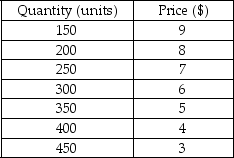 -Refer to the table above.What is the marginal revenue of the monopolist when it sells 200 units of its product?
-Refer to the table above.What is the marginal revenue of the monopolist when it sells 200 units of its product?
A) $2
B) $5
C) $7
D) $9
Correct Answer

verified
Correct Answer
verified
Multiple Choice
A monopolist faces a linear,downward-sloping demand curve.If the slope of the demand curve is 1 and the monopolist can sell one unit of output at a price of $10,what is the total revenue from selling the fourth unit of output?
A) $28
B) $20
C) $34
D) $7
Correct Answer

verified
Correct Answer
verified
Multiple Choice
The following figure shows the demand curve faced by a monopolist.
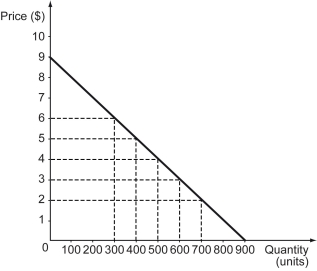 -Refer to the figure above.What is the change in total revenue due to a price increase from $3 to $5?
-Refer to the figure above.What is the change in total revenue due to a price increase from $3 to $5?
A) Total revenue increases by $100.
B) Total revenue decreases by $100.
C) Total revenue increases by $200.
D) Total revenue decreases by $200.
Correct Answer

verified
Correct Answer
verified
Multiple Choice
Among the following,which is the best example of price discrimination?
A) Air fares are usually more expensive in December.
B) A local transit company allows senior citizens, the unemployed, and children to ride at reduced fares.
C) Taxi fares vary according to the distance traveled.
D) Cinemas usually charge lower prices on Tuesdays.
Correct Answer

verified
Correct Answer
verified
Multiple Choice
Which of the following is an example of a good produced under monopoly?
A) DVDs
B) Books
C) Aerated drinks
D) Patented software
Correct Answer

verified
Correct Answer
verified
Multiple Choice
Which of the following statements is true of a monopolist's supply curve?
A) The supply curve is vertical.
B) The supply curve is upward-sloping.
C) The supply curve is downward-sloping.
D) A monopolist does not have a supply curve.
Correct Answer

verified
Correct Answer
verified
Multiple Choice
In the long run,a monopolist ________.
A) will earn zero economic profits
B) always earns positive economic profits
C) may earn positive economic profits
D) will produce where Price = Marginal cost
Correct Answer

verified
Correct Answer
verified
Multiple Choice
Peak-load pricing is when a firm charges a different price during the peak (e.g.,highest demand) period than during off-peak times,because the marginal cost of providing the good or service during the peak is higher.For example,an electricity producer builds generating capacity to serve peak-period demand but only needs to call on this full capacity during a handful of days of the year.Building capacity to meet peak demand means that there is a discrete change in the marginal cost of providing the good or service across a binding capacity constraint.Is this an example of price discrimination? If so,to which degree? If not,explain why not.
A) Yes; first-degree price discrimination
B) Yes; second-degree price discrimination
C) Yes; third-degree price discrimination
D) No; because the good or service is not the same (it has different marginal costs in peak versus nonpeak periods)
Correct Answer

verified
Correct Answer
verified
Multiple Choice
A copyright is a source of ________ market power.
A) legal
B) natural
C) regulated
D) competitive
Correct Answer

verified
Correct Answer
verified
Multiple Choice
A socially optimal price maximizes ________.
A) consumer surplus and minimizes producer surplus
B) producer surplus and minimizes consumer surplus
C) total surplus
D) deadweight loss
Correct Answer

verified
Correct Answer
verified
Multiple Choice
The following figure shows the costs and revenue curves of a firm in a monopoly market.
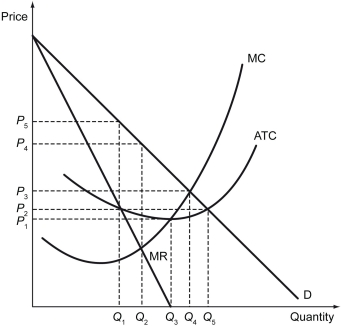 -Refer to the figure above.If the government decides to regulate this market,the best strategy would be to ________.
-Refer to the figure above.If the government decides to regulate this market,the best strategy would be to ________.
A) set the price at $3
B) set the price at $2
C) levy a $2 tax on the monopolist
D) levy a $1 tax on the monopolist
Correct Answer

verified
Correct Answer
verified
Multiple Choice
The following figure shows the marginal revenue (MR) curve and the demand curve faced by a monopolist. The monopolist faces a constant marginal cost of $3.
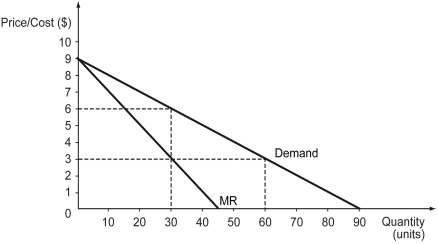 -Refer to the figure above.What is the price at which the monopolist should sell its output?
-Refer to the figure above.What is the price at which the monopolist should sell its output?
A) $3
B) $4
C) $6
D) $9
Correct Answer

verified
Correct Answer
verified
Multiple Choice
Scenario: When a monopolist charges $5 for its product, it sells 250 units of the product. When it decreases the price of the product to $4, it sells 325 units of the product. -Refer to the scenario above.What is the quantity effect of the price change?
A) $50
B) $75
C) $150
D) $300
Correct Answer

verified
Correct Answer
verified
Multiple Choice
Which of the following is NOT true of price discrimination among units of output?
A) Output is generally larger than under a single-price monopoly.
B) Any given level of output yields a larger total revenue than a single-price monopoly.
C) If discrimination does not increase output, consumer surplus diminishes.
D) Lower-income individuals will always be charged lower prices.
Correct Answer

verified
Correct Answer
verified
Multiple Choice
Tobac Co.is a monopolist in cigarette market in Nicotiana Republic,where the U.S.dollar is used as the official currency.The firm faces the demand curve shown below.The firm has a constant marginal cost of $2.00 per pack.If Tobac Co.could successfully carry out the first-degree (or perfect) price discrimination,the social surplus would ________ and the consumer surplus would be ________.
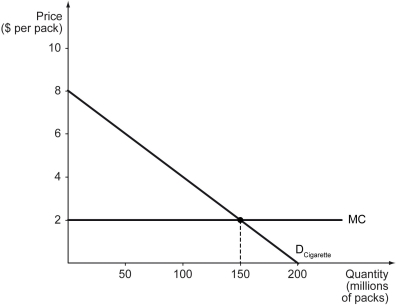
A) not be maximized; $112.5 million
B) not be maximized; $0
C) be maximized; $0
D) be maximized; $450 million
Correct Answer

verified
Correct Answer
verified
Multiple Choice
The following figure shows the marginal revenue (MR) and demand curves faced by a monopolist.
 -Refer to the figure above.If the monopolist faces a constant marginal cost of $2,at what price should it sell its output?
-Refer to the figure above.If the monopolist faces a constant marginal cost of $2,at what price should it sell its output?
A) $2
B) $6
C) $10
D) $12
Correct Answer

verified
Correct Answer
verified
Multiple Choice
If a monopolist decides to charge a higher price for its product,it will yield a ________ revenue per unit sold and ________ number of units sold.
A) lower; higher
B) lower; lower
C) higher; lower
D) higher; higher
Correct Answer

verified
Correct Answer
verified
Showing 61 - 80 of 295
Related Exams